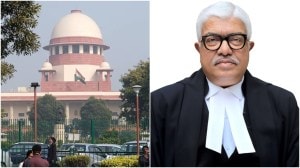Night of Dec 31 to Jan 1 dawn, relief camp diary
It’s 8.30 pm in this two-acre stretch of slush, brightly lit, bang in the middle of the gathering darkness. The third pair of lights to...

It’s 8.30 pm in this two-acre stretch of slush, brightly lit, bang in the middle of the gathering darkness. The third pair of lights to appear in the last half an hour wobble up the empty water-scarred road, to the Kallar relief camp in Nagore near Nagapattinam, Black Sunday’s Ground Zero, where until today the toll stands at 5,819.
The headlights, bright, silhouette the flies, the specks of dust the wheels have kicked, and the men in surgical masks who slither down the sides of the van.
With them is Palanivel, he reeks of arrack.
Palanivel has Kallar’s face after the tsunami—deep furrows, hollowed-out cheeks—but not its desperation. He doesn’t belong to Kallar.
Until last Sunday, he had a home in Akkaraipadi, a few kilometres away, a wife, two grandchildren and a catamaran. The wife and the children have vanished, so have the home and the catamaran, all swallowed up by the sea. There aren’t any neighbours left either. Many died, others fled. So Palanivel rides on relief vans from camp to camp—there are still 20 more to go—just in case he finds them in one.
On the other side is a canal, filth and debris overflowing, tops of crushed and sliced-off roofs sticking out, electric posts that snapped vainly puncture the night sky.
To the south, is a small village temple, where an idol of Lord Shiva sits half-covered in dried mud. This was a little village of over 1,600 people. The waves left 127 dead—20 are missing, probably more.
A diesel generator sputters in the middle of the camp, to feed the six stage lights the village moneylender had hired. Around 350 men, women and children mill around. The stench is overpowering—from the bleaching powder, and from the decaying debris, human waste and the mud. It is Day 5 and, so far, the government’s contribution has been a lone policeman and a visit by the District Collector.
9 pm: A group of volunteers from an NGO troop in. ‘‘The government destroyed the sand dunes in many places to beautify beaches for tourists. The water wouldn’t have come in so fast if the dunes stayed,’’ one of them says.
9.15 pm: Four-year-old Sharada wakes up on a piece of cloth on the sand to find her mother isn’t around, and screams. A man pauses to take her in his arms, yells for her mother. Soon, a woman ambles in from the shadows, picks up the child and disappears. It’s not her mother.
9.30 pm: A relief van from Indian Youth Movement, Kumbakonam, drives up the road. Men adjust their masks, and start handing out raw rice. This is the fifth van to come this evening with the same relief: rice and old clothes. Clothes begin piling up along the broken road, waiting for takers. But the rice is soon over. There is rice, no vessels to cook it in; bundles of old clothes, but no toilets and no medicines.
A young fisherman carries a two-year-old boy picked up from near a temple, asking if he belongs to someone. There are no claimants, yet.
11 pm: Camp gets set to sleep. The policeman yells at a few men slanging it out, women join in chorus. A baby in a cloth cradle hangs from a broken electric post, he cries too. Dogs howl. A volunteer swears at a stray cow nibbling at sacks of relief supplies piled up behind the temple. The generator trips, lights flicker.
11.30 pm: Still no sign of Sharada’s mother. The child now sleeps with the old woman who took her.
11.45 pm: A young volunteer, Sabhapathy, conducts a relief team from Andhra around the sands. A bunch of women say they need milk for the babies. Sabhapathy tells them there are only water packets. The relief team drives off, leaving some rice and clothes—again.
Midnight: Sabhapathy looks at his watch, yawns, wakes up the sleeping policeman and pumps his hand. An old man wrapped in layers of donated shirts sits up, lights a beedi and stares at the two. Flies flit around the lights. A woman wails in her sleep.
Another breeze, another wave, and I retch. I rush to the car to wake up the driver and head for my airconditioned cocoon in Hotel Subham Park. Its manager, Nasser, doubles as the lone waiter. For, all 35 of his staff fled the day the waves struck. His staff have returned. New Year. SMS wishes from another world clog my cellphone.
I return to Kallar shortly after daybreak. The first relief vans have arrived; there is a jostle for water, kids are waking up. Somewhere among them, there must be Sharada.





- 01
- 02
- 03
- 04
- 05


























